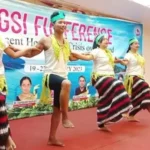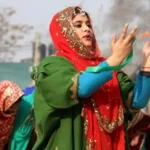As the name truly signifies, Uttar Pradesh is the heartland of India. The state is not only famous for the century long history and cultural diversity, but also the captivating art activities. The dance forms of the state are truly amazing, filling up the cultural taste bud of hundreds of tourists who visit the place year. Here in this post we will discuss about these dance forms and their significances.
1. Kathak: The Dance of Storytellers

Kathak, a renowned classical dance form originating in Uttar Pradesh, particularly within the Nawabs of Lucknow courts are elegant and expressive. Its story, complex footwork, and emotive facial expressions captivate audiences worldwide. In Sanskrit, “katha” means “story” and “katha kaar” means “storyteller.” Kathak dancers perform singly or in groups with live music, captivating the senses. Kathak’s trademark “tala,” or footwork, has complex rhythms and patterns that provide depth. This aural journey is augmented by “ghungroos,” musical anklets that create a symphony with each step. Kathak uses Hindu epics, myths, and history. Kathak’s story entertains and educates about India’s culture. Kathak is a classic art form with beauty and narrative. Lucknow courts started it, and it today entertains and educates people worldwide.
2. Ras Leela: The Divine Dance Drama
Hindu mythology and spirituality underpin Uttar Pradesh’s Ras Leela dance. This devotional dance depicts Lord Krishna’s adoration for Vrindavan’s lovely Gopi cowherd women. In vibrant Radha and Gopis-inspired costumes, the young girls dance intricately, showing their love and devotion. Ras Leela transcends dancing to spirituality. A devout mood builds as the players represent Radha and the Gopis and the audience is fascinated by their ability. This shared experience unites and spiritualizes. Krishna and the Gopis’ love story is immortalized by Ras Leela. This dance transports performers and spectators to devotion and divine love. Hindu spirituality’s boundless love may alter people when earthly and divine merge.
3. Ramlila: The Epic Drama in Motion
The popular dance-drama Ramlila depicts Lord Rama’s life narrative, centering on the Ramayana. This spectacular display is generally held during Dussehra, the festival of good against evil. Cities and towns perform this classic annually. Actors with elaborate costumes and makeup portray Ramayana characters. Ramlila goes beyond dancing to be complete. Music, dialogue, and beautiful landscape transport viewers to Lord Rama’s wonderful world. Energy and enthusiasm from performers and audience create a lovely environment. Ramlila represents storytelling and art in Uttar Pradesh for millennia.
4. Charkula Dance: The Dance of Balance
Charkula Dance, a popular Braj dance from Mathura and Vrindavan, Uttar Pradesh, is captivating. Ladies carry a big wooden “charkula” on their heads while executing this elegant dance. Oil lamps, flowers, and other ornaments adorn the charkula. This complex garment creates a beautiful light and color show. Lord Krishna’s childhood and amusing escapades are told in the charkula dance. Artistic elements include storytelling and the dancers’ graceful use of the heavy charkula and intricate dance moves. Uttar Pradesh’s historic Charkula Dance balances art with physical power, making it difficult and beautiful. The dancers’ synchronized movements and exquisite charkula create a breathtaking vision of dedication and story. This tradition honors Braj people’s devotion to Lord Krishna’s stories.
5. Nautanki: The Folk Theatrical Dance
A captivating traditional dance-drama, Nautanki, arose in rural Uttar Pradesh. Dance, music, and drama evoke love, heroism, and societal issues in this dynamic art form. Energy-packed “nautankiwalas,” who go from village to village, erect makeshift stages that host local entertainment. Nautanki shows include energetic dances, amusing chat, and lovely music. Its ability to entertain all ages and backgrounds distinguishes it. Nautanki is amusing and reflects its time with stories of love, folklore, and societal critique. The vibrant Nautanki story provides communities joy and connection. It offers a reprieve from rural life and connects people to their roots, preserving traditions and fostering identity.
6. Birha: The Soulful Lament
Birha, also known as “Biraha” or “Biraha Sangeet,” is a strong Uttar Pradesh folk dance and musical art form, notably among the Ahir and Yadav tribes. This stunning picture captures the anguish of separation and unrequited love. Birha tells painful stories of couples torn apart by fate or culture to show the actual feelings of unfulfilled love. Birha concerts are captivating, with powerful vocalists and dancers expressing profound emotions via refined expressions and movements. Birha relies on these artists’ capacity to express their feelings via performance. Traditional instruments like the “dholak” and “shehnai” add to the narrative’s emotional impact.
7. Chhapeli: The Expressive Folk Dance
Chhapeli, a Kumaon folk dance, is popular among Paharis. The community’s rich history and culture are celebrated in this lively dance. Chhapeli has rapid feet, elegant hand motions, and expressive expressions. Theatre dancers with vivid costumes and elaborate jewelry embody Pahari culture. The heart of dance is movement and music. Chhapeli performances are accompanied by harmonious Pahari “dhol,” “damau,” and “turi.” These instruments energize the dancers’ complex choreography. Chhapeli is more than entertainment—it communicates Pahari joy, camaraderie, and heritage. They honor their culture and community with this dance. Paharis may celebrate and share their culture.
Conclusion
The cultural heritage of Uttar Pradesh is well known. From the scholars to the art lovers, people from every sphere of the cultural society have praised the way the state has nurtured the art form through the years. From Kathak, to Ram Leela, every dance form holds its distinct attributes. This diversity of artistic expression, though the years, have captured the imagination of the thousands.
Santosh Kumar, the author behind IndiasStuffs.com, is passionate about sharing valuable insights on a variety of topics, including lifestyle, technology, and Indian culture.
Page Contents

